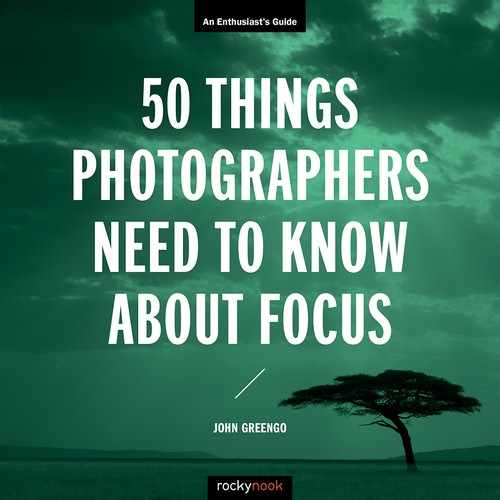18. FOCUS LOCK FOR A BETTER COMPOSITION
![]()
FOCUS LOCK IS one of most basic but useful techniques with an autofocus camera. This will only work when the camera is in Single AF Mode. The purpose of this is to allow you to focus on a particular subject and then recompose the frame as you wish. This gives you the best of both worlds: the focus point you desire and the framing of your choice.
The shutter release button is key to this technique. When the shutter button is not being pressed the camera will power down and go into sleep mode in order to save battery power. This sleep mode will usually start after about 10 to 30 seconds of inactivity, but can be modified on some cameras.
When you press the shutter release lightly, you will reach the halfway press. If the camera is in sleep mode, first it will wake up, then it will activate the metering system, and then it will start the autofocus. When pressing halfway to engage focus, be sure to keep your finger at the halfway step until the camera has focused. It may take several seconds. Many lenses make an audible noise when focusing and you may be able to hear when it stops, which would indicate that focus has been achieved. Many cameras by default have an audible “beep beep” to confirm focus. If you find this distracting you can turn it off in the menu system. Most cameras also offer a visual confirmation as to whether focus was achieved or not. Some cameras will blink a green or red box on the selected focus area, while others may have an indicator somewhere else in the display. Check your manual to see what your camera offers.
When focus has been achieved, the lens is focused and locked on a specific distance from the camera. The lens will not refocus until you lift your finger off the shutter release and press back down to the halfway mark. If you leave your finger at the halfway position, you can move the camera around as much as you like and the focus will remain set for that distance. This technique of focus, lock, and recompose is quick and easy, and it works well for many subjects.
Focus Lock is not a solution to all problems, and there are a couple of issues to be aware of. First, this only works in Single AF Mode, which means it won’t work well with moving subjects. Secondly, as you are moving the camera to a new position, you may inadvertently change the camera-to-subject distance. The result will be that your subject is slightly out of focus. This error is most likely to happen with very shallow depth-of-field lens focused at a close distance. When shooting portraits or shallow depth-of-field images, it is recommended that you move the focus point to the desired area rather than using the Focus Lock technique.

Focus Lock is an easy technique to use when you want your primary subject to be off-center in the frame.
ISO 200; 1/400 sec.; f/5.6; 270mm; Fujifilm X-T2
Keeping the primary subject in sharp focus is easy with Focus Lock.
ISO 100; 1/5 sec.; f/11; 10mm; Fujifilm X-T2

Focus Lock is perfect for unconventional compositions.
ISO 100; 1/5 sec.; f/11; 173mm; Sony ILCE-7RM2

